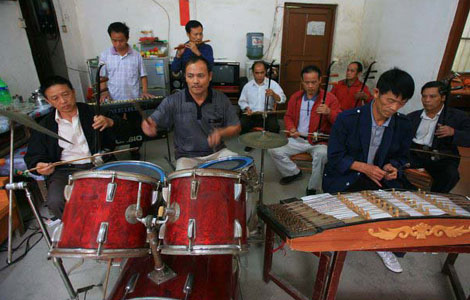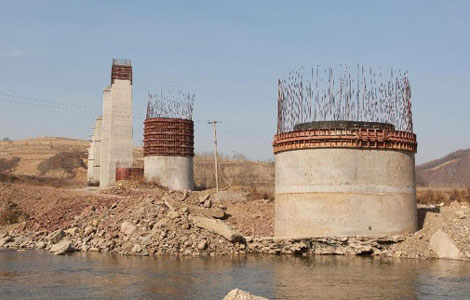China, ASEAN to cement economic ties
Updated: 2011-10-23 16:27
(Xinhua)
|
|||||||||||
NANNING - China and the Association of Southeast Asian Nations (ASEAN), two of Asia's most dynamic economies, are set to overcome differences and difficulties to forge closer ties and sustain growth as uncertainties weigh on the world economy.
For Wang Jianmin, a border trade dealer in Pingxiang City of southwest Guangxi Zhuang Autonomous Region, China-ASEAN cooperation must not be derailed under any circumstances.
"The better China-ASEAN relations are, the better my business is," said Wang, who started dealing fruits at the border in 1993, two years after China and ASEAN established dialogue relations.
Wang became a fruit wholesaler in 2001 and saw his business take off after China and ASEAN slashed tariffs substantially on more than 500 kinds of products in 2004.
Now he is importing more than 10 tonnes of apples, pears and oranges every day from north and central China to ASEAN countries such as Vietnam.
Fast expanding China-ASEAN economic ties in the past two decades have benefited merchants but also exposes obstacles in infrastructure and coordination as well as political and economic differences among China and the 10 ASEAN members.
Challenges loom
The latest incident that disturbed business people like Wang was the death of 13 Chinese sailors after two cargo ships were attacked and hijacked by unknown armed men on October 5 in the Mekong River's "golden triangle" area, where the borders of Myanmar, Thailand and Laos meet.
The Mekong River flows through China, Myanmar, Laos, Thailand, Cambodia and Vietnam to the South China Sea. It plays a crucial role in trade and transport throughout the Greater Mekong Sub-region (GMS) countries, namely China, Myanmar, Thailand, Laos, Cambodia and Vietnam.
The incident shows more efforts should be made to improve infrastructure and better coordinate social management among China and ASEAN countries to facilitate economic cooperation, experts said.
As the flow of goods, human resources and capital increased in the region, more disputes and conflicts will be brought to light, said Nong Lifu, deputy head of the southeast Asian research institute with the Guangxi Academy of Social Sciences.
China and ASEAN saw trade surge 37.5 percent year-on-year to 292.8 billion U.S. dollars in 2010, almost 37 times the amount in 1991, customs figures showed.
Bilateral trade ballooned after the launch of China-ASEAN Free Trade Area (CAFTA) in 2010, which reduced the average tariff on goods traded between China and a majority of ASEAN countries to near zero.
"The most important issue after the establishment of the CAFTA is to promote the interconnection in the China-ASEAN region, but it is also the biggest difficulty," said Li Chenyang, director of the southeast Asian research institute at Yunnan University.
Different levels of development and financial strength of the region's 11 countries have obstructed the construction of transport, telecommunications and energy networks across the region.
Lack of coordination is another problem. For example, cargo trucks cannot travel freely between ASEAN countries because of legal constraints and fruits from Thailand have to be shipped by sea or transferred via Vietnam, which is more costly and time-consuming, said Artapron Puthikampol, Consul General of Thailand in Nanning.
"There exists vast potential for our cooperation in infrastructure and such 'software' development as institution building and personnel exchanges," Premier Wen Jiabao said in a speech at the opening ceremony of the eighth China-ASEAN Business and Investment Summit in Nanning on Friday.
Huge economic gaps, different political systems, territorial disputes and inadequate mutual trust have impeded financial cooperation in the China-ASEAN region, according to a report released by the Research Institute of Finance and Banking of the People's Bank of China (PBOC) in Nanning on Saturday.H ? China and ASEAN will face multiple challenges in the political, economic, social and environmental areas in their future cooperation, said Loh Geok Mooi, former senior fellow with the Institute of Strategic and International Studies Malaysia.
"The key is to enhance communication and build trust and follow the principle of equality and mutual benefits," she said.
Cooperation urged
Considering the economic woes in Europe and the U.S. and their impact on Asian exports, China and ASEAN should look for alternative sources of growth and further increase trade within the region, Malaysian Prime Minister Najib Tun Razak said Friday at the eighth China-ASEAN Expo, which was held along with the China-ASEAN Business and Investment Summit in Nanning from October 21 to 26.
There is still huge room for trade growth, he said, noting that China and ASEAN aim to boost annual bilateral trade volume to 500 billion U.S. dollars in 2015.
ASEAN has embarked on a right path of opening up to and closely cooperating with China, whose stability and development is crucial to the region's growth, said Cambodian Prime Minister Hun Sen at the investment summit on Friday.
He called for the completion of a railway project intended to connect Kunming in southwest China and Singapore, which will enhance the interconnection in the China-ASEAN region.
China and ASEAN will work together to build ASEAN into an economic community by 2015, he said.
China has set up a 10 billion-U.S. dollar China-ASEAN Fund on Investment Cooperation and pledged 15 billion U.S. dollars of loans to ASEAN countries to support infrastructure projects in the China-ASEAN region and to enhance economic ties.
Hun Sen also called for lowering non-tariff trade barriers such as quarantine requirements to help more farm produce from less-developed ASEAN member states enter the Chinese market.
Despite a huge surplus in its total national trade, China registered a trade deficit of 16.3 billion U.S. dollars with ASEAN in 2010, up by more than 30 times from the previous year, with its imports from ASEAN rising faster than exports to the bloc.
China's huge market will attract more investment by companies from ASEAN countries, said Nguyen The Nhan, sales manager of a Vietnamese scale company subsidiary in Dongxing City.
Investment and operation will definitely be affected if trade protectionist sentiments rise, said Nhan, whose Nhon Hoa Scale DongXing Co., Ltd. produces over 1.8 million spring scales annually and sells them all in China.
Wen said Friday China and ASEAN "will rise above political, economic, religious, cultural and other differences ... and move our cooperation forward toward common prosperity," as long as they act in the spirit of equality, mutual trust and seek common ground while shelving differences.
Incidents like the death of the Chinese sailors on the Mekong River will not impact the China-ASEAN economic cooperation, said Danny Chian Siong Lee, community affairs development director of the ASEAN's Corporate and Community Affairs Department.
Governments in the China-ASEAN region firmly agree to the importance of regional stability and growth, he said, while calling for more people-to-people exchanges to avoid public misgivings.
"We want good relations, peace and stability, which will lead to prosperity for everyone ... Regional conflict is not doing anyone any good," he said.
Hot Topics
New sex education textbooks were introduced to pupils in Shanghai on Monday after numerous debates on early-age sex education in China.
Editor's Picks

|

|

|

|

|

|







